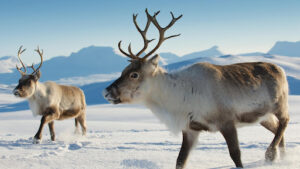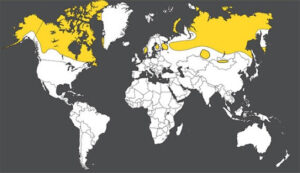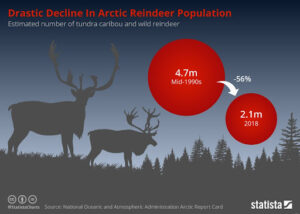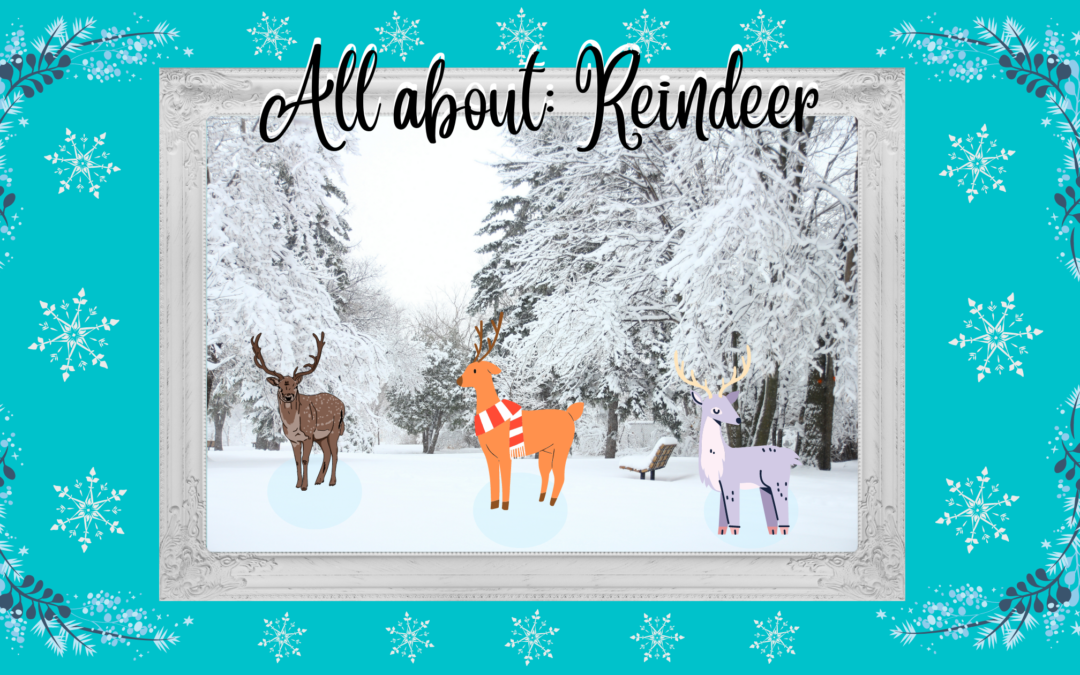Written by: Kiya Tavascia
Did you know reindeer and caribou are technically the same species? Still, even though they are the same species (Rangifer tarandus), they have both perceived and real differences in North America. The perceived differences are brought about by changes in the way we think about reindeer. Why? Mostly because of our beloved Christmas stories. After all, don’t we relate reindeer to Rudolph and Santa’s sleigh more than anything?
The real differences are present when referring to reindeer as we are basically saying ‘domesticated caribou’. In fact, in North American reindeer is the commonly used term for domesticated caribou, while caribou is used for those of the species in the wild. In Europe, they typically use ‘reindeer’ as the blanket term for all members of the species. It’s a bit confusing, eh? For the purposes of this post, we’ll refer to both domesticated and wild Rangifer tarandus as ‘reindeer’ (but remember, caribou is also correct!).

Reindeer are mammals and are a member of the deer family. Reindeer are the only deer species that have been domesticated in large numbers. This has led to some differences with their wild counterparts. “Domesticated reindeer are docile, short-legged, stocky and seek out the company of humans, more beast of burden than wilderness icon.” (CGS)
Unlike other species in the deer family, both males and females grow antlers. Their average height is about 6 feet including their antlers, which is similar to a full-grown man. And, they weigh 250-700 pounds. They are covered in hair from their noses to the bottom of their hooves. They are also the only deer species with hair covering their noses, which can be attributed to the cold climates in which they reside. Their hairy hooves are important for gripping snow and ice too.
They are herbivores that eat plants including grasses, shrubs, mosses, herbs, ferns, and more. The average adult reindeer eats 9 to 18 pounds of vegetation each and every day! You may be wondering what they eat during winter when many plants cease to grow. Lichen – also called reindeer moss, is what they typically live off of, as well as some fungi.
Reindeer are the prey of many carnivores and omnivores including grey wolves, lynx, black bears, coyotes, and golden eagles. They are an important food source to many animals in northern Canadian ecosystems. Reindeer are found in the Arctic Tundra and adjacent boreal forests ecosystems of Greenland, Scandinavia, Russia, Alaska, and Canada. In Canada, reindeer can be found in most provinces. They are not typically found in Nunavut, New Brunswick, Nova Scotia, or Prince Edward Island.

Reindeer have a big impact on the ecosystems they live in. They play a major role in the food chains and webs. If they were to be removed from the ecosystem, many species would be affected. Any species that eat reindeer would be losing a food source, which could lead to their population lowering over time. The vegetation that they eat would be able to grow more, which could be good as it would leave more vegetation for other animals to eat. But, the vegetation could start to take over the land and become an invasive species. Nature tends to act in harmony when left alone, and the elimination of any species from that carefully balanced design can have wide-reaching, tragic effects.
Unfortunately, reindeer populations are declining across Canada due to the destruction of old-growth forests that serve as their primary habitat. This has led to them now being considered a species threatened with extinction. In response to this looming and devastating possibility, “The Nature Conservancy’s Canadian affiliate, Nature United is safeguarding 10 woodland caribou herds in northwest Manitoba by mapping out where they have the best chance at a future and working with Indigenous peoples, government and industry to conserve these priority areas” (The Nature Conservancy, 2019).

References:
https://www.ealt.ca/blog/fun-facts-reindeer-vs-caribou
https://www.fda.gov/animal-veterinary/animal-health-literacy/fun-facts-about-reindeer-and-caribou
https://www.wcs.org/our-work/species/caribou
https://www.nature.org/en-us/about-us/where-we-work/canada/stories-in-canada/canadas-reindeer/
https://www.fda.gov/animal-veterinary/animal-health-literacy/fun-facts-about-reindeer-and-caribou
https://blog.nature.org/science/2015/12/23/holiday-treat-what-difference-between-reindeer-caribou/
Image Sources:
https://www.ealt.ca/blog/fun-facts-reindeer-vs-caribou
https://animals.sandiegozoo.org/animals/reindeer-caribou
https://www.statista.com/chart/16388/estimated-number-of-tundra-caribou-and-wild-reindeer/

